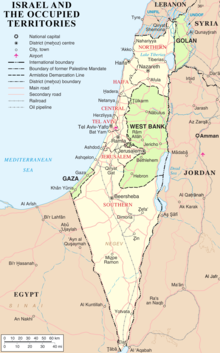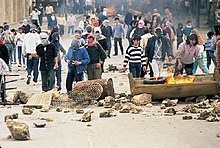Intifada
Intifada (Arabic: انتفاضة) is an Arabic word. In Arabic, intifada means "shaking off".[1] An intifada can be seen as a way for people to "shake off" a power that is oppressing them, a so called "uprising" against that power. The term Intifada is most famous for the two Palestinian uprisings in the 1980s and 2000s. These two intifadas are considered part of the Israeli-Palestinian conflict. There were also other intifadas outside of Palestine, the protests in Bahrain against British presence from 1965 until 1972 are called the 'March Intifada'.

List of intifadas
[change | change source]The First Intifada took place from 1987 to 1993, when Palestinians rebelled against the Israeli power.
The Second Intifada began in 2000 and lasted until 2005. This Intifada is sometimes called the Al-Aqsa Intifada and was also where Palestinians rebelled against the Israeli power.
The March Intifada in Bahrain broke out in March 1965 and protests were renewed every year until 1972.[2] This Intifada was about people from Bahrain against the British power.
First Intifada (1987-1993)
[change | change source]The period of the first Intifada started on 9 December 1987[3][4] and ended with the Oslo accords in 1993. This Intifada lasted a total of six years.
The Palestinian unrest which led to the outbreak of the first intifada started with the Israeli settlements on Palestinian territory, forcing Palestinians to leave their land.[1] Other reasons for the Palestinian rebellion were the worsening economy and the limited access to jobs.[5]
Start of the First Intifada
[change | change source]The first protests against Israel's occupation erupted in Gaza. A car belonging to the Israeli army drove into a Palestinian car, killing all four occupants on 8 December 1987. That night, protests broke out in a Palestinian refugee camp during the funeral of the victims.[5] It became a Palestinian mass uprising against the occupation, Palestinians came into active resistance.[4][5]
A party (Unified National Leadership of the Uprising: UNLU) was established which brought together all important Palestinian organizations and parties that already opposed Israel before the Intifada.[4]
Casualties and overview
[change | change source]The first Intifada is often known for its nonviolent nature. The nonviolent resistance from Palestinians existed of the boycott of Israeli products, strikes and the refusal to pay taxes or other obligated payments to Israel.[6] However, the idea that the intifada was nonviolent is not correct. The more violence Palestinians used the more violent the Israeli responses became.[1][7]


In 1989 the Israeli security forces switched to extreme violent tactics in this period.[6] The Israeli tactics from this period led to a peak in Palestinian violence as well.
An estimated number of 1282 Palestinians died and more than 130.472 became injured during the six year period of the Intifada.[8] For every three Palestinians that died, less than one Israeli was killed.
End of the First Intifada
[change | change source]The Intifada officially ended on the 13th of September 1993, when the Declaration of principles was signed by the PLO and Israeli government.[9] This declaration was also the start of the Oslo accords, in which Palestine and Israel would start to discuss the many issues on autonomy, borders, refugees and Jerusalem.[9]
Second Intifada (2000-2005)
[change | change source]The period of the Second Intifada is marked from September 2000[10] until February 2005,[11] even though opinions may differ about when it ended. The Second Intifada was more violent than the first.[10]
Overview
[change | change source]After the First Intifada ended in 1993, there was still a lot of discontent among the Palestinians. They didn't agree with how the Oslo accords were followed by Israel.[12] When the Israeli premier Ariel Sharon visited the Temple Mount in a provocative way, it was the last straw for the Palestinians. This is why some people also call this uprising the 'Al-Aqsa Intifada'.[10]
The Second Intifada began with Palestinian demonstrations. These started in Jerusalem, but quickly spread to the West Bank. In the beginning the Palestinians mostly threw rocks and were not obedient towards the Israelis, the Israelis were heavily armed.
Later on, the Palestinians used other, more deadly tactics. Some of them were suicide bombings, snipers and rocket attacks.[13]
In 2002, during the Second Intifada, the Israeli government decided to build a barrier between Israel and the West Bank.
Another important event during the Second Intifada was the Israeli withdrawal from the Gaza Strip. This happened after things escalated between Hamas and the Israeli occupiers, which resulted in many deaths on both sides.
The ending and aftermath
[change | change source]In 2005, after more than 5 years, the Second Intifada came to an end. In 2004 the intensity of the uprising was already fading. This was because of the Palestinians becoming weary, struggling against the strong lasting Israeli defense.[14]
The Second Intifada was more violent than the first one, causing over 3000 Palestinian and nearly 1000 Israeli deaths.[15]
March Intifada (Bahrain)
[change | change source]In March 1965 an Intifada broke out in Bahrain. The goal of the uprising was to stop the British presence in Bahrain.[16] This Intifada was mostly led by groups with leftists ideas. Multiple people died, because of the violence the police used several times during the demonstrations. The protests started when a huge amount of workers from the Bahrain Petroleum company resigned. It changed fast into a general strike against the British.
The protests continued to happen annually until 1972. In 1972 the government agreed to talk with the opposition and they allowed three members from the workers union to join the government. The Bahrain Intifada took officially from 1965 to 1975.[2]
References
[change | change source]- ↑ Jump up to: 1.0 1.1 1.2 "intifada | History, Meaning, Cause, & Significance | Britannica". www.britannica.com. Retrieved 2022-05-09.
- ↑ Jump up to: 2.0 2.1 "The March Intifada - Bahrain, 1965 | libcom.org". libcom.org. Retrieved 2022-05-16.
- ↑ Freedman, Robert O. (1991). The Intifada - Its Impact on Israel, the Arab World, and the Superpowers. Miami: University press of Florida. pp. XI. ISBN 9780813010403.
- ↑ Jump up to: 4.0 4.1 4.2 Naser-Najjab, Nadia; Khatib, Ghassan (2019). "The First Intifada, Settler Colonialism, and 21st Century Prospects for Collective Resistance". The Middle East Journal. 73 (2): 187–206. doi:10.3751/73.2.11. ISSN 1940-3461. S2CID 200032600.
- ↑ Jump up to: 5.0 5.1 5.2 Lesch, Ann M. (Autumn 1990). "Prelude to the Uprising in the Gaza Strip". Journal of Palestine Studies. 20, nr. 1 (1): 12. doi:10.2307/2537319. JSTOR 2537319.
- ↑ Jump up to: 6.0 6.1 Nasrallah, Rami (2012), "The First and Second Palestinian Intifadas", Routledge Handbook on the Israeli-Palestinian Conflict, Routledge, doi:10.4324/9780203079553.ch5, ISBN 978-0-203-07955-3, retrieved 2022-05-09
- ↑ McGinn, Jack. "A study of grassroots political organising during, and in the years immediately preceding, the first Intifada as an example of anarchist praxis".
{{cite journal}}: Cite journal requires|journal=(help) - ↑ Lopez-Ibor, Juan José; Christodoulou, George; Maj, Mario; Sartorius, Norman; Okasha, Ahmed (2005-01-28). Disasters and Mental Health. John Wiley & Sons. ISBN 978-0-470-02124-8.
- ↑ Jump up to: 9.0 9.1 "Milestones: 1993–2000 - Office of the Historian". history.state.gov. Retrieved 2022-05-09.
- ↑ Jump up to: 10.0 10.1 10.2 "intifada | History, Meaning, Cause, & Significance | Britannica". www.britannica.com. Retrieved 2022-05-12.
- ↑ publication., Tucker, Spencer C. (1937- ...)., Directeur de la (2019). Middle East conflicts from Ancient Egypt to the 21st century : an encyclopedia and document collection. Bloomsbury Academic. ISBN 978-1-4408-5352-4. OCLC 1155694634.
{{cite book}}: CS1 maint: multiple names: authors list (link) CS1 maint: numeric names: authors list (link) - ↑ Redactie, Auteur. "Intifada - Opstand van de Palestijnen". Historiek (in Dutch). Retrieved 2022-05-12.
- ↑ Beauchamp, Zack (2018-11-20). "What were the intifadas?". Vox. Retrieved 2022-05-12.
- ↑ "The Second Intifada 2000". Anti-Defamation League. Retrieved 2022-05-12.
- ↑ "Just Vision". justvision.org. Retrieved 2022-05-12.
- ↑ "The March Intifada - Bahrain, 1965 | libcom.org". libcom.org. Retrieved 2022-05-18.
